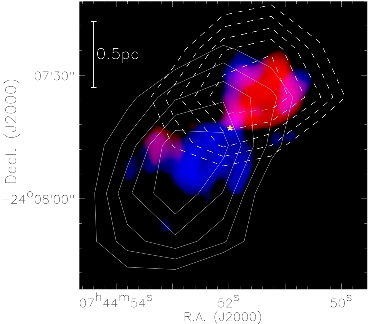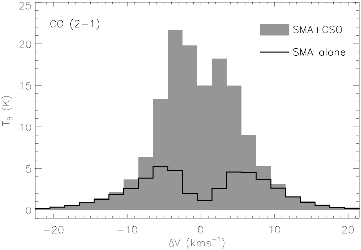
 CSO
captures an early stage of massive star formation with SMA.
CSO
captures an early stage of massive star formation with SMA. 
The processes forming
massive stars (with masses greater than 8 times the mass of our Sun)
remain a mystery to astronomers.
Flows of gas, often with two lobes moving in opposite directions away
from the central star thus called bipolar outflows,
are known as the most remarkable characteristic of star
formation. In the formation of a low-mass star (like the Sun),
bipolar outflows are thought to carry away angular momentum from the
materials falling inward toward the star; those
materials would otherwise continue spinning rather than falling onto
the star. However, the nature of bipolar outflows
associated with massive star formation is poorly understood.
To advance our knowledge of massive outflows and put firm
constraints on theories of massive star formation, the
scientists in China, U.S.A. and Taiwan, led by Dr. Keping Qiu at
Nanjing University and Harvard-Smithsonian
Center for Astrophysics, observed a bipolar outflow in a massive star
forming site G240.31+0.07, using the Caltech
Submillimeter Observatory (CSO) 10.4-meter telescope and the
Submilliter Array (SMA, an 8-element interferometer),
in February 2008. They observed emissions from CO (a typical tracer of
molecular gas in the Milky Way and
extragalaxies) and its isotopologue 13CO to probe the
outflow structure. While an interferometer is powerful in revealing
fine structures at high-angular-resolution, its capability of picking
up extended structures is limited by the shortest distance
between two elements. This shortage is crucial to outflow studies since
outflows have parsec (200,000 AU) sized scales.
The only way to overcome this shortage is to add in data taken with a
single-dish telescope. Figure 1 demonstrated that
the CSO data effectively pick up large structures of the outflow
whereas the SMA observations resolve the inner part
into a bi-conical, wide-angle outflow. Furthermore, it is
immediately evident from Figure 2 that only with the combined
CSO and SMA data, the scientists can reliably measure the flux level of
the emission, and consequently reliably calculate
the gas mass in the outflow, which amounts to about 100 times the mass
of the Sun.
A detailed analysis of the data shows that the outflow is
morphologically and kinematically similar to outflows in
low-mass stars, but with two to three orders of magnitude greater mass
and energetics. Hence, it suggests that massive
stars can form as a scaled-up version of low-mass star formation. The
results will be published in the 2009 April 20 issue
of The Astrophysical Journal (Qiu, Zhang,
Wu, and Chen 2009).

Figure 1. CSO
and SMA observations in CO (2-1) of the bipolar outflow in
G240.31+0.07. The CSO data are shown in contours, with
approaching (blue-shifted) material in solid lines and receding
(red-shifted) material in dashed lines. The SMA data are color-coded
blue for approaching and red for receding gas. A yellow star denotes
the site of the massive young star driving the outflow.

Figure 2. The CO (J=2-1) spectra toward
the outflow center. The gray filled histogram shows the spectrum
constructed from the combined
CSO and SMA data, and the black line histrogram shows the spectrum from
the SMA data alone. It is clear that a significant fraction of the
CO emission at low velocities is missed in the SMA data alone, but can
be effectively recovered with the combined CSO and SMA data.
Go back to A Digest of Recent News and
Scientific Results at the Caltech Submillimeter Observatory

 CSO
captures an early stage of massive star formation with SMA.
CSO
captures an early stage of massive star formation with SMA. 

 CSO
captures an early stage of massive star formation with SMA.
CSO
captures an early stage of massive star formation with SMA. 

